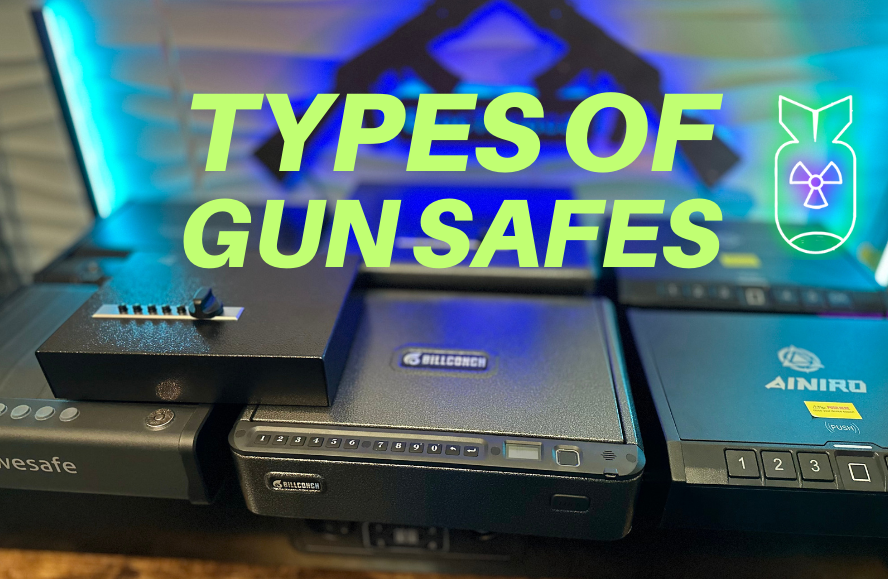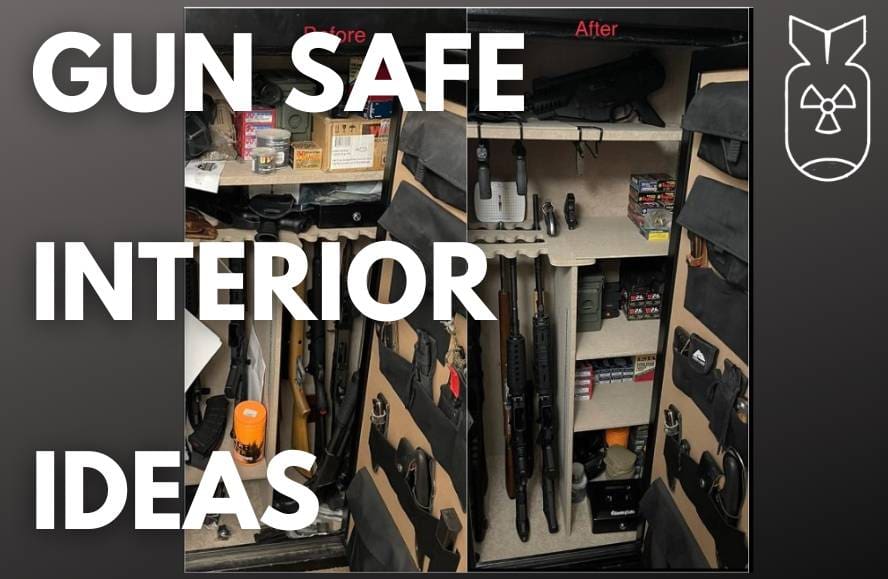Choosing the right size for your gun safe is a crucial but often overlooked aspect of securing your firearms and other valuables.
This comprehensive guide aims to walk you through the key considerations, from assessing your current collection to planning for future acquisitions and understanding the types of safes available to meet your particular needs.
Armed with this knowledge, you’ll be better equipped to make an informed decision that balances your storage needs with security features, ensuring a long-lasting and reliable sanctuary for your firearms.
10-Step Gun Safe Size Guide
Here are 10 easy steps to help you figure out how big a safe you’ll need to house your firearm collection:
1. Assess Your Current Firearm Collection
The process of choosing the right size for your gun safe should invariably start with a careful assessment of your current collection.


Knowing what you have and how much space it occupies is the baseline for making an informed decision.
Here’s how to go about it:
Inventory Your Firearms
Begin by taking a detailed inventory of all the firearms you own. This includes not just rifles and handguns, but also any smaller firearms like compact pistols.
Don’t forget to count spare barrels or alternate stocks that may need to be stored!
Pro Tip: Make a list or spreadsheet to help you keep track. Include dimensions if possible, to get a sense of the space each item requires.
Consider the Accessories
Firearms often come with a range of accessories such as scopes, grips, extended magazines, and ammunition.
These will need to be stored securely as well, either in the same safe or a different location depending on your preference and legal requirements.
Pro Tip: Factor in the volume of these accessories in addition to your firearms when calculating the space you’ll need.
Measure, Don’t Guess!
It might sound simple, but physically measuring your collection can provide you with invaluable data.
Utilize a tape measure to gauge the length, height, and width of your firearms, especially if you own long guns like rifles or shotguns.
Pro Tip: Remember to consider any protruding elements like scopes or bipods that might require additional space.
Consider Presentation
While storage efficiency is important, how your guns are stored can also matter. Some people prefer to have their firearms easily accessible and presented in a way that allows for quick retrieval.
Others might prioritize compact, secure storage.
Pro Tip: Decide what matters more to you—presentation or efficiency—as this will impact the size and type of safe you choose.
Number of Users
If more than one person in your household will be accessing the safe, you may need to consider additional storage compartments or even multiple safes of different sizes to accommodate everyone’s needs.
Pro Tip: Multi-user access might require a safe with different sections or advanced locking features that allow for multiple combinations of biometric data.
Evaluate Special Requirements
Some firearms have special storage needs. Antique guns, for example, may require climate-controlled conditions.
Collectibles that you don’t use may need a display case within the safe.
Pro Tip: If you have any firearms with unique storage needs, factor these into your size calculations.
Thoroughly assessing your current collection is the cornerstone of choosing the right-sized safe.
Once you have a clear understanding of your existing needs, you can more effectively consider other factors like future-proofing, material, security features, and budget constraints.
2. Future-Proof Your Purchase
When shopping for a gun safe, it’s easy to focus solely on your immediate needs. However, what may be sufficient today could quickly become inadequate as your collection grows or your storage requirements change.
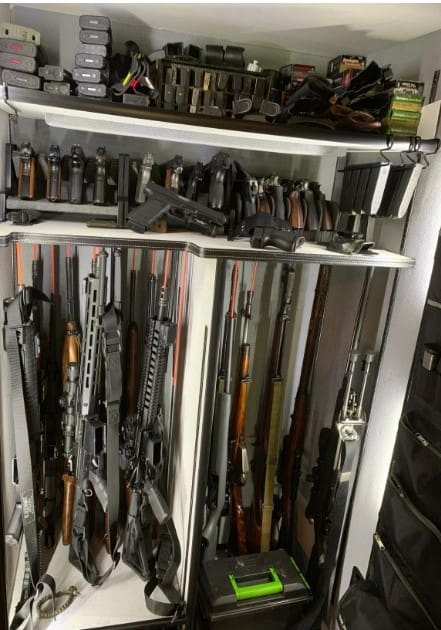

Future-proofing your purchase means planning for what you might need down the road, not just what you need right now.
Here’s how to approach this:
Anticipate Growth
Whether you’re a collector or someone who regularly uses firearms for sport or work, your collection is likely to grow over time.
New models come out, interests change, and before you know it, you may require significantly more storage space.
Pro Tip: As a general rule, consider purchasing a safe with at least 25–30% more space than you currently need to accommodate future additions.
Versatility is Key
Some safes come with adjustable shelving or modular interiors that allow you to customize the space as per your needs.
This is an excellent feature for future-proofing your purchase as it provides the flexibility to rearrange the internal layout when you acquire more firearms or accessories.
Pro Tip: Safes with versatile interiors might cost a bit more upfront but can save you from needing an upgrade somewhere down the road.
Consider Multi-Functional Safes
Many modern gun safes offer more than just storage for firearms. They come with compartments for documents, jewelry, and other valuables.
Even if you don’t need this now, you might in the future.
Pro Tip: Look for safes that offer multi-functional storage without compromising on the security features essential for firearms.
Think About Technological Upgrades
As technology evolves, newer safes come equipped with features like biometric scanners, smartphone connectivity, or advanced alarm systems.
While your immediate need might be met by a basic lock-and-key mechanism, your future self might thank you for opting for more advanced features.
Pro Tip: Safes with upgradable tech features can adapt to emerging security trends, providing you with a longer-lasting product.
Future Resale Value
If you’re making a considerable investment, it’s worth considering the safe’s potential resale value.
High-quality safes from reputable brands tend to hold some second-hand value but it’s hard to even give away those cheaper no-name brands.
This can be a factor if you ever outgrow your current safe and need to sell it to upgrade to a larger one.
Pro Tip: A well-maintained safe with good documentation and a reputable brand name is more likely to fetch a decent resale price.
By taking a future-oriented approach, you ensure that your investment remains useful and relevant for years to come.
In doing so, you’re not just buying a safe; you’re buying peace of mind, knowing that you won’t outgrow your purchase anytime soon.
3. Type of Firearms
The types of firearms you own—handguns, rifles, shotguns, or a mix of these—will significantly impact the size and configuration of the gun safe you’ll need.


Each type of firearm has its specific storage requirements, and understanding these can help you make a more informed choice.
Here are some factors to consider based on the type of firearms in your collection:
Handguns
Handguns typically require less space compared to long guns. If you primarily own handguns, a smaller safe with shelving or dedicated handgun racks might be sufficient.
Pro Tip: Some safes come with door organizers designed specifically for handguns, freeing up interior space for other items.
Rifles
Rifles, especially those with scopes or other attachments, require a lot of vertical space. If you have several rifles, you’ll want to consider a taller safe with ample height and depth to accommodate them.
Pro Tip: Look for safes with barrel retention or rifle racks that help maximize space and keep your long guns organized and easy to access.
Shotguns
Like rifles, shotguns require a safe with generous vertical space. However, because shotguns can be bulkier, especially if you have added attachments like extended chokes or stocks, you may also need extra depth and width in your safe.
Pro Tip: Consider safes with adjustable shelves or removable sections to tailor the interior space to the dimensions of your shotguns.
Mixed Collection
If you have a mix of handguns, rifles, and shotguns, versatility is key. Look for safes that offer a combination of features like removable shelves, modular storage, and multiple sections.
Pro Tip: Some safes come with convertible interiors, allowing you to switch between configurations to accommodate different types of firearms.
Specialty Firearms
If your collection includes antique or rare firearms, these might have special storage needs like climate control or extra cushioning.
Make sure the safe you choose can accommodate these requirements.
Pro Tip: Customizable safes with the ability to add humidity control or specialized padding can be a good option for specialty firearms.
Range or Field Gear
If you frequently take your firearms to a range or out in the field, you may also need to store associated gear like hearing protection, range bags, or cleaning kits.
This should be accounted for when calculating the size of the safe.
Pro Tip: Dedicated compartments for gear and accessories can help keep everything organized and easy to find.
By carefully considering the type of firearms you own, you can zero in on a gun safe that is both appropriately sized and well-suited to your particular needs.
The goal is to find a balance between size, accessibility, and storage versatility, allowing you to securely store your collection in the most efficient way possible.
4. Additional Storage Needs


While the primary function of a gun safe is to secure your firearms, the reality is that many people use their safes for a variety of other storage needs.
From important documents to family heirlooms, these items can also impact the size of the safe you’ll require. Here’s how to account for these additional storage needs:
Important Documents
Many individuals use their gun safe to store important papers such as passports, birth certificates, and property deeds.
If you plan on doing the same, you’ll need to account for the extra space this will require.
Pro Tip: Look for safes with dedicated document compartments or pouches, or consider a safe with a built-in lockbox for added security.
Ammo Storage
If you have a large collection of ammunition, that too will require a considerable amount of space.
Some gun safes come with built-in ammo storage compartments, but you can also allocate a shelf or section for this purpose.
Pro Tip: Factor in not just your current ammo stash but also potential future purchases when calculating space requirements.
Valuables and Heirlooms
Items like jewelry, watches, and other valuable possessions often find their way into gun safes. These items may require special compartments with padding or even separate lockboxes within the safe for added security.
Pro Tip: Check if the safe has customizable shelves or drawers for storing valuables. If it doesn’t, you may need to size up to accommodate these items.
Electronics and Media
You might want to store electronic items like hard drives, flash drives, or even laptops in your safe.
These will not only need space but also possibly electrical outlets or USB ports for charging or continuous operation.
Pro Tip: Some modern safes come equipped with internal electrical outlets and USB ports. Consider these features if you plan on storing electronics.
Emergency Supplies
Many people store emergency items like flashlights, first aid kits, or even non-perishable food and water in their safes.
These can take up a substantial amount of room, so don’t forget to account for them.
Pro Tip: Safes with door organizers can be excellent for storing smaller emergency supplies without taking up shelf space.
Seasonal or Rarely Used Items
Items that you don’t need to access regularly but still want to keep secure can also impact the size of the safe you choose. This could range from seasonal gear to collectibles.
Pro Tip: Consider whether you need these items to be easily accessible or if they can be stored in harder-to-reach areas of the safe.
By accounting for these additional storage needs, you ensure that the safe you choose is versatile and fully aligned with your lifestyle.
It’s always better to overestimate your storage needs than to find yourself running out of space sooner than you anticipated.
Ammunition and Magazines
Ammunition can take up a surprising amount of space, especially if you own multiple calibers or prefer to buy in bulk.
You might also have different types of magazines, speed loaders, or clips that need storage. Consider designated compartments or shelves in your safe for these items.
Pro Tip: Ammunition can be heavy, so consider the weight limits of internal shelves or the safe itself when fully loaded.
Optics and Accessories
Scopes, laser sights, and other optical accessories can be bulky and may require extra padding or compartments for secure storage.
If you have removable optics, ensure that you allocate space for them in your safe.
Pro Tip: Some safes come with door organizers or pockets that can be ideal for storing smaller optics and accessories.
Cleaning Kits and Maintenance Supplies
Regular upkeep of your firearms is essential, and having your cleaning kits and maintenance supplies at arm’s reach is convenient.
Make sure you have room for cleaning rods, oils, solvents, and other maintenance equipment.
Pro Tip: Many cleaning supplies are flammable; ensure your safe has appropriate safety certifications.
Personal Documents and Valuables
Gun safes often double as secure storage for important personal documents like passports, property deeds, or even cash and jewelry.
While these might not be your primary concern, allocating a small compartment or shelf for such items can be extremely beneficial.
Pro Tip: Some safes offer a separate lockbox within the main compartment for storing documents and valuables.
Miscellaneous Items
From spare keys to electronic devices and emergency supplies, you may have additional items you’d like to store in your safe.
These also require space and should be included in your size considerations.
Pro Tip: Assess your needs annually as your storage requirements may change with new acquisitions or lifestyle changes.
By accounting for these additional storage needs, you can select a gun safe that’s not just a fit for your firearms but also an all-encompassing secure storage solution.
A slightly larger safe can often provide the extra room you need, offering a more versatile and long-term storage option.
5. Physical Space Constraints
While it may be tempting to go for the largest safe that can store all of your firearms and more, the physical space available in your home will often dictate what is feasible.
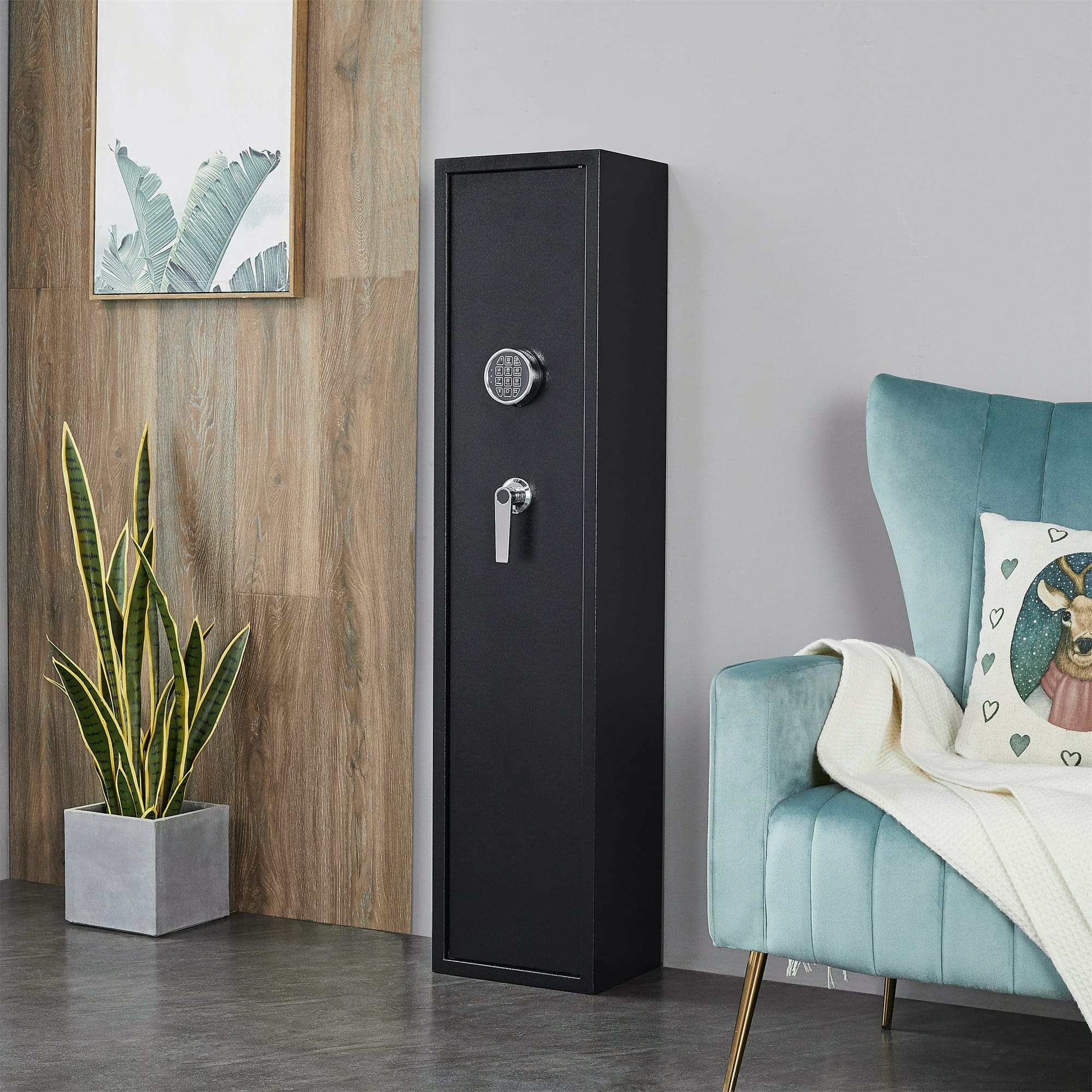

Neglecting to consider space constraints can lead to a host of problems, from delivery difficulties to installation woes. Here’s how to factor in the physical space constraints in your home:
Floor Area
First and foremost, measure the floor area where you plan to place your safe. Not only should the safe fit, but you should also have adequate room to open the door fully and access its contents comfortably.
If you’re placing it in a closet, consider the swing radius of the door. Also, make sure there is room for any anchors or bolts if you plan to secure the safe to the floor.
Pro Tip: Leave at least a few inches of clearance on each side for proper ventilation and to account for any irregularities in the floor or wall.
Ceiling Height
Especially relevant for tall rifle safes, make sure that your ceiling height is sufficient to accommodate your chosen safe.
This is also important if you’re considering a safe that opens upwards rather than to the side.
Pro Tip: If you’re placing the safe on a carpet or adding a platform for any reason, these should be factored into your ceiling height calculations.
Doorways, Stairs, and Hallways
Getting the safe into your home is another logistical concern. Measure all doorways, stairwells, and hallways that the safe will need to pass through.
This includes the front door, internal doors, and any tight turns in hallways or staircases. Keep in mind that safes are heavy, and navigating tight spaces can be challenging.
Pro Tip: Before purchasing, check if the safe’s dimensions are provided “with handles and dial” or “without handles and dial,” as this can affect its ability to fit through doorways.
Load-Bearing Capacity
Last but not least, ensure that the location you’ve chosen can bear the weight of the safe. This is particularly important if you’re considering placing the safe on an upper floor or in an area with potential structural vulnerabilities.
In some cases, you may need to consult a structural engineer to make sure your home can handle the additional weight safely.
Pro Tip: If you’re installing the safe on a wooden floor, it might be advisable to place it along a wall where floor joists are strongest.
Taking time to consider these physical space constraints can save you a lot of trouble down the line, ensuring that your chosen gun safe is not just secure and adequately sized, but also a good fit for your home.
6. Types of Gun Safes
When it comes to selecting the right size for your gun safe, understanding the various types available on the market can help you make a more informed decision.
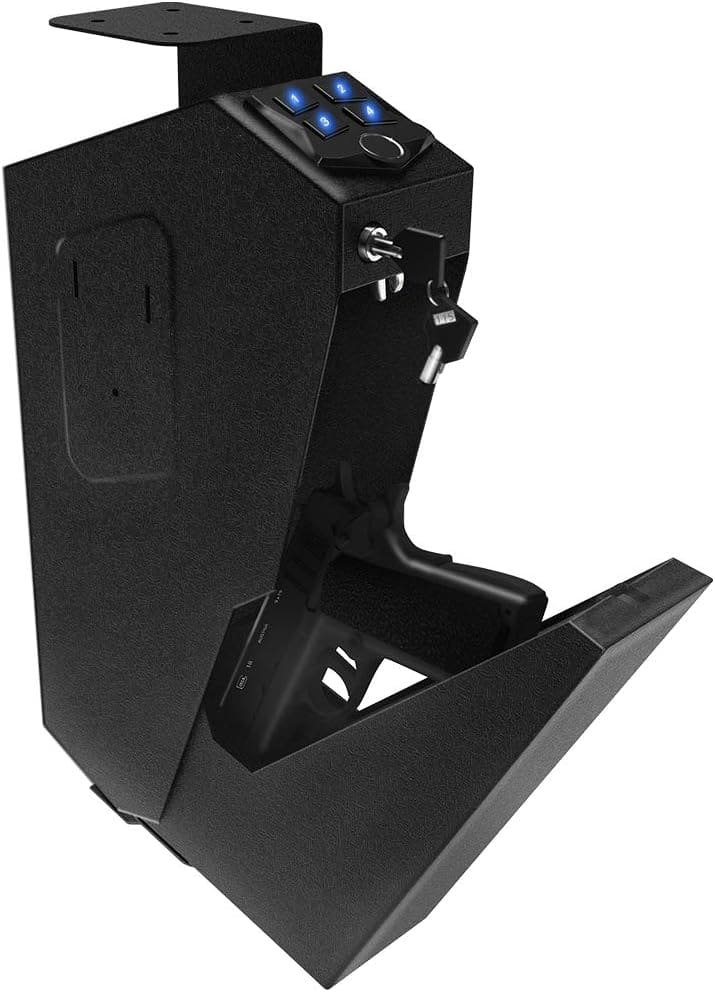

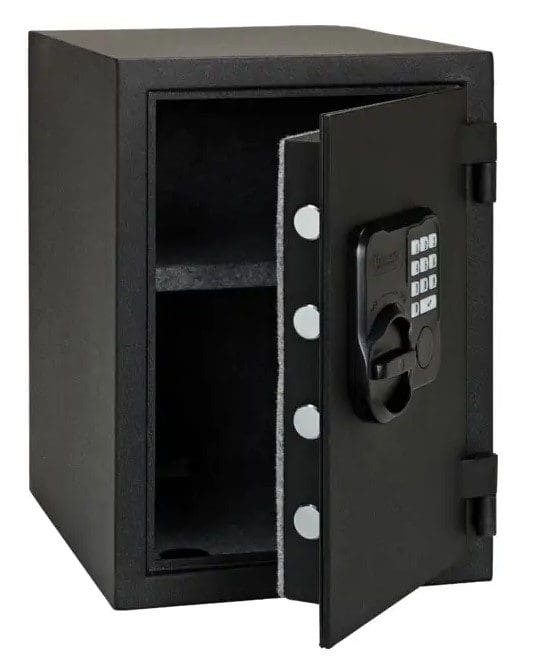



Each type has its unique size characteristics and is designed to cater to specific storage needs.
Here are the main types of gun safes you’re likely to encounter:
Handgun Safes
These safes are the smallest in size and are designed explicitly for handguns and pistols. Generally compact, they can easily fit in small spaces, such as in drawers, closets, or even under your bed.
They often come with foam interiors to protect the handguns and may have compartments for magazines or small accessories.
Size-wise, they usually measure between 0.5 to 1.2 cubic feet in internal storage space.
Ideal For: Individuals who primarily own handguns and have limited space for a safe.
Rifle Safes
These safes are designed for storing long guns like rifles and shotguns. Naturally, they are much taller and may also be wider to accommodate the guns’ length and any mounted optics like scopes.
Many come with slots or racks to hold each rifle upright, as well as additional compartments or shelves for accessories.
You can expect these safes to offer 5 to 25 cubic feet of internal storage space, depending on the model.
Ideal For: Firearm enthusiasts with a collection of long guns and associated accessories like scopes, bipods, and slings.
Multi-Use Safes
As the name suggests, these safes are versatile and can be adapted for a variety of storage needs. They often come with adjustable shelves or compartments, allowing you to store both handguns and long guns.
Their sizes can range dramatically, from 2 cubic feet for smaller models up to 40 cubic feet for larger units.
Ideal For: Those with a diverse collection of firearms, as well as other valuables like documents or jewelry, that require a one-stop storage solution.
Specialty Safes
Apart from the above categories, you may also come across safes designed for very specialized needs.
These could include:
- Tactical Safes: Designed with specific compartments for tactical gear.
- Portable Safes: Small safes designed for travel, usually meeting TSA guidelines for firearm transport.
- In-wall or In-floor Safes: These are installed in your home’s structure and can vary significantly in size based on your custom requirements.
Ideal For: Specific use cases that go beyond standard storage needs.
Understanding the characteristics and sizing of these different types of gun safes will enable you to select one that aligns perfectly with both your present and future needs.
7. Key Measurements
Once you’ve assessed your collection, future needs, and available space, it’s time to delve into the nitty-gritty of measurements.
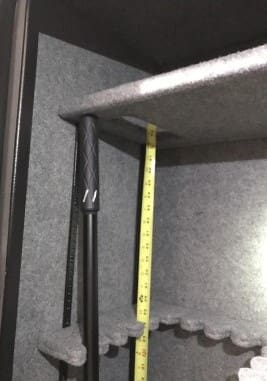

Selecting the right size for your gun safe involves considering both its external and internal dimensions, as well as some less obvious factors. Here are the key measurements to focus on:
External Dimensions
The external dimensions of a safe, typically listed in the product specifications, will tell you how much floor and wall space the safe will occupy.
When considering these dimensions, also factor in any protruding elements like the handle, dial, or hinges.
Pro Tip: Take into account any clearance you may need on all sides of the safe for practical use and installation, such as opening the door or securing the safe to the wall or floor.
Internal Dimensions
These dimensions will give you an idea of how much storage space is available inside the safe. This is crucial for understanding what can fit in it.
Manufacturers often list the internal cubic feet, which can serve as a helpful guideline for your storage needs.
Pro Tip: The presence of shelves, gun racks, and other internal features can reduce the effective storage space, so always overestimate your space needs slightly.
Door Swing Radius
The door swing radius is the amount of space needed for the door to open fully. This is particularly important if you plan to place the safe in a restricted area like a closet or a corner.
If the door can’t open fully, accessing your firearms and other items can become cumbersome.
Pro Tip: Door swing radius is seldom provided in product specifications, so you may need to calculate this based on the door’s width and hinge design.
Wall Thickness
Though not a ‘size’ in the traditional sense, the thickness of the walls and door are key measurements when it comes to the safe’s ability to resist tampering and environmental hazards like fire.
The thicker the walls, the more secure the safe, but this also increases its overall size and weight.
Pro Tip: Safes with thicker walls often have reduced internal storage capacity, so balance your security needs with your storage requirements.
Weight
While not a linear measurement, the weight of a safe is a crucial factor to consider, especially for installation.
Heavier safes are generally harder to move, providing an additional layer of security, but ensure your chosen location can handle the weight.
Pro Tip: If your safe needs to be carried up or down stairs for installation, consider the logistics and any additional equipment or manpower that may be needed.
Understanding these key measurements in detail will arm you with the information needed to choose a gun safe that perfectly aligns with your storage needs, physical space constraints, and security requirements.
Always measure twice and order once to avoid any costly mistakes!
8. Weight and Installation
While size and storage capacity are often the first considerations when selecting a gun safe, the weight of the safe can be just as important.
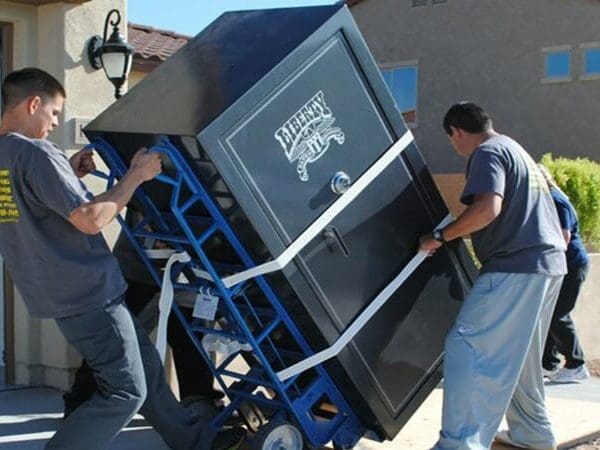

Weight not only influences the safe’s security but also has critical implications for its installation.
Here’s how to consider weight and installation when making your choice:
Why Weight Matters
The weight of a safe is often directly proportional to its security features. Heavier safes are generally harder to move, acting as a deterrent against theft.
Pro Tip: The general rule of thumb is that a safe should weigh at least 750 pounds empty to deter single-person theft attempts effectively.
Weight Distribution
The distribution of the weight is also crucial, especially for tall rifle safes. If most of the weight is at the bottom, the safe will be more stable.
However, if you plan on storing heavy items on adjustable shelves, consider how that might affect the safe’s stability.
Pro Tip: Check if the safe has options for anchoring to add extra stability regardless of weight distribution.
Installation Site Weight Capacity
Before you pick out a heavy safe, make sure the installation site can bear the weight. This is especially important for upstairs installations, where structural integrity could be compromised.
Pro Tip: Consult a structural engineer if you’re unsure about the weight-bearing capacity of your chosen location.
Installation Logistics
Transporting a heavy safe into your home can be a complicated affair. Consider the route from the delivery truck to the safe’s final location, keeping in mind doorways, hallways, and stairs that need to be navigated.
Pro Tip: Some companies offer ‘white-glove’ installation services, which include the safe’s delivery and setup, potentially saving you a lot of time and effort.
Anchoring the Safe
For safes that are lighter or are going to be located in high-traffic areas, anchoring to the floor or wall adds an extra layer of security.
Make sure the safe has pre-drilled holes for this purpose and that your chosen location allows for such modifications.
Pro Tip: Anchoring is recommended even for heavier safes as a best practice to prevent any possibility of tipping or moving the unit.
Professional Installation
Given the complexities and potential challenges of installing a heavy safe, professional installation can be a wise investment.
This is particularly true for safes that require being bolted to the floor or wall or those that have complicated locking mechanisms that need expert setup.
Pro Tip: When opting for professional installation, confirm whether the service includes a warranty or any post-installation support.
Weight and installation are integral aspects that often go overlooked in the process of choosing a gun safe.
By carefully considering these factors, you can ensure that your chosen safe not only provides the necessary security but is also safely and properly installed in your chosen location.
9. Safety and Security Features
When choosing the right size for your gun safe, you shouldn’t compromise on safety and security features. Here are the essential factors to consider:
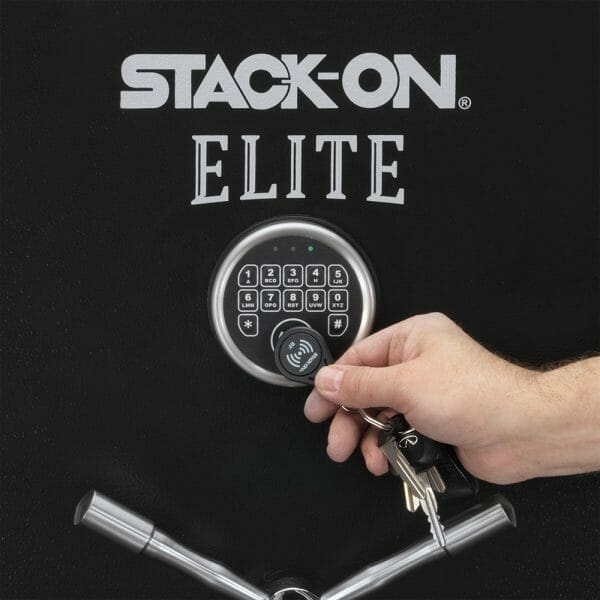

While size and storage capacity are paramount, a gun safe should foremost serve its primary function: to secure your firearms and valuables.
Here are some important features to look out for:
Locking Mechanism
The type of lock on your gun safe can significantly influence its overall security. There are several options to choose from, including combination dials, electronic keypads, and biometric scanners.
Your choice may depend on how quickly you need to access the contents.
Pro Tip: Some safes offer multiple locking mechanisms for added security. Make sure to choose a lock that you are comfortable using regularly.
Steel Gauge
The thickness of the steel used in the safe’s construction plays a significant role in its ability to withstand physical attacks.
The lower the gauge, the thicker the steel. For a high-security safe, look for a rating of at least 10-gauge steel.
Pro Tip: Heavier gauge steel not only provides greater security but also adds to the safe’s overall weight, further deterring theft.
Fire Resistance
A good gun safe should offer some level of fire resistance. This is usually indicated by the amount of time the safe can withstand high temperatures without the internal temperature exceeding a certain point, commonly 350°F.
Pro Tip: Check for a fire rating from a reputable third-party testing agency for greater assurance.
Anchor Points
Anchor points allow you to secure the safe to the floor or wall, providing an additional layer of security. Anchoring is especially important for lighter safes, which are easier to move.
Pro Tip: Look for safes with pre-drilled anchor holes to simplify the installation process.
Anti-Tampering Features
Advanced safes come with anti-tampering features such as relockers that trigger an additional locking mechanism if tampering is detected, or anti-pry tabs that make it difficult to force the door open.
Pro Tip: Anti-tampering features are often not standard in basic models, so inquire about these when shopping for a safe.
Alarm Systems
Some modern safes come equipped with alarm systems that can alert you or the authorities in case of unauthorized access attempts. These can be particularly useful in high-risk environments.
Pro Tip: Connectivity features like Wi-Fi or Bluetooth can allow you to monitor the safe remotely, although this might require ongoing subscription fees.
Interior Lighting
Though not strictly a security feature, internal lighting can help you access your firearms and other valuables safely in low-light conditions.
Pro Tip: LED lighting is energy-efficient and can run on batteries, thus not relying on an external power source.
By paying close attention to these safety and security features, you can choose a gun safe that provides peace of mind in addition to meeting your size and storage requirements.
Remember, the best gun safe is one that seamlessly blends size, functionality, and most importantly, robust security features.
10. Budget Considerations
Choosing the right size for your gun safe is not just a matter of assessing your current and future storage needs; it’s also about balancing those requirements with your budget.


While it’s tempting to opt for a safe with all the bells and whistles, financial constraints often require compromise.
Here’s how to approach budget considerations without sacrificing too much on quality or security:
Setting a Budget
Before you start shopping, have a clear idea of how much you’re willing to spend. Safes can range from a couple of hundred dollars for basic models to several thousand for high-security, feature-rich options.
Pro Tip: Make a list of must-have features and nice-to-haves, so you know where you can compromise if needed.
Cost vs Size
Generally, the larger the safe, the higher the cost. However, opting for a slightly larger size than is currently required can be a cost-effective decision in the long run, as it saves you from needing to upgrade later on down the road.
Pro Tip: Assess your projected needs for the next 5–10 years to determine an appropriately sized safe that falls within your budget.
Cost vs Material
Stronger materials like thicker steel gauges or advanced locking mechanisms can significantly add to the cost.
While it may be tempting to save money by going for cheaper materials, this could compromise the safe’s security.
Pro Tip: Always prioritize key security features even when working with a tight budget.
Brand and Warranty
Brand reputation can play a role in cost. Established brands with positive reviews are often more reliable but may come at a premium.
Additionally, consider the warranty offered, as this can add long-term value to your purchase.
Pro Tip: Sometimes spending a bit more upfront for a reputable brand with a strong warranty can save you money in the long run.
Extra Features and Customization
High-end safes often come with additional features like fireproofing, biometric locks, internal lighting, or even Wi-Fi connectivity. While nice to have, these can add to the overall cost.
Pro Tip: Stick to features that meet your core needs to stay within budget. You can often add some customizations later.
Installation Costs
Don’t forget to account for the cost of delivery and installation, which can be substantial, especially for heavier safes. Some companies include this in the price, while others do not.
Pro Tip: Ask about installation costs upfront and factor this into your total budget.
Financing Options
Some companies offer financing options, which can help you afford a more secure or larger safe without breaking the bank.
However, remember that financing often comes with interest rates.
Pro Tip: If opting for financing, read the terms carefully to ensure that you understand the long-term cost implications.
By keeping these budget considerations in mind, you can make an informed decision that balances size, features, and cost.
This way, you’ll end up with a gun safe that meets your needs without causing financial strain.
Final Thoughts
Choosing the right size gun safe involves multiple considerations, including your existing collection, potential future acquisitions, type of firearms, additional storage needs, and physical space constraints.
Thoroughly evaluating these factors will help you make an informed decision, leading to a long-lasting investment that ensures both the security of your firearms and your peace of mind.
Remember, the size serves as the cornerstone for other important features like the locking mechanism, material quality, and environmental resistance.
Invest the time and effort now to choose wisely, and you’ll have a secure and functional storage solution for years to come.


